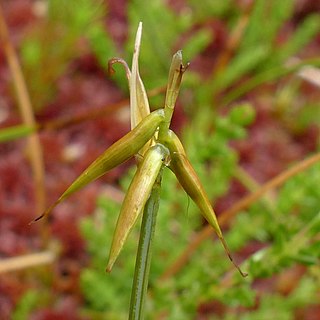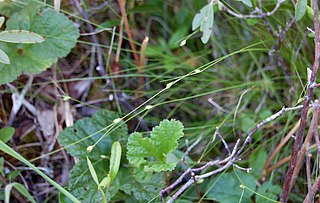
The Cyperaceae are a family of graminoid (grass-like), monocotyledonous flowering plants known as sedges. The family is large; botanists have described some 5,500 known species in about 90 genera – the largest being the "true sedges", with over 2,000 species.

Carex is a vast genus of over 2,000 species of grass-like plants in the family Cyperaceae, commonly known as sedges. Other members of the family Cyperaceae are also called sedges, however those of genus Carex may be called true sedges, and it is the most species-rich genus in the family. The study of Carex is known as caricology.

Uncinia is a genus of flowering plants in the family Cyperaceae, known as hook-sedges in Australia and as hook grasses or bastard grasses in New Zealand. The genus is characterised by the presence of a long hook formed by an extension of the rachilla, which is used to attach the fruit to passing animals (epizoochory), especially birds, and it is this feature which gives the genus its name, from the Latin uncinus, meaning a hook or barb.

Carex nigra is a perennial species of plants in the family Cyperaceae native to wetlands of Europe, western Asia, north Africa, and eastern North America. Common names include common sedge, black sedge or smooth black sedge. The eastern limit of its range reaches central Siberia, Turkey and probably the Caucasus.

Carex pauciflora, the few-flowered sedge, is a perennial species of sedge in the family Cyperaceae native to bogs and fens in cool temperate, subarctic, and mountainous regions of the Northern Hemisphere. The specific epithet pauciflora refers to the Latin term for 'few flowered'.
Georg Kükenthal was a German pastor and botanist who specialized in the field of caricology. He was the brother of zoologist Willy Kükenthal (1861–1922).

Carex siderosticta is a species of sedge native to East Asia. It is the only species of Carex known to produce "pseudo-lateral" culms, which appear to be lateral, but derive from the apical meristem. It is the type species of Carex subg. Siderosticta.

Carex subg. Carex is a subgenus of the sedge genus Carex. It is the largest of the four traditionally recognised subgenera, containing around 1400 of the 2000 species in the genus. Its members are characterised by the presence of one or more exclusively male (staminate) terminal spikes, quite dissimilar in appearance from the lateral female (pistillate) spikes below. In most species, the female flowers have three stigmas, but a few species, including Carex nigra, have female flowers with only two stigmas.

Carex subg. Vignea is a subgenus of the sedge genus Carex, containing around 300 of the 2000 species in the genus. Its members are characterised by having bisexual, sessile spikes, where the female flowers have two stigmas each.

Carex viridula, known as little green sedge, green sedge, or greenish sedge, is a small flowering plant native to North America, Europe, Asia, and Morocco.
Peter William Ball is an English-born botanist, plant collector, and plant taxonomist, specializing in caricology.

Carex remota, the remote sedge, is a species in the genus Carex, native to Europe, the Atlas Mountains in Africa, and western Asia. It is a riparian forest specialist. It is known as one of the most frequently hybridizing species of Carex, forming hybrids with C. appropinquata, C. arenaria, C. brizoides, C. canescens, C. divulsa, C. echinata, C. elongata, C. leporina, C. otrubae, C. paniculata, and C. spicata.

Carex flava, called hedgehog grass, is a widespread species of sedge, native to the northern United States, Canada, Iceland, Europe, the Atlas Mountains in Africa, the Transcaucasus area, and parts of Siberia. It is the namesake of the Carex flava species complex.

Carex divulsa, the grey sedge, is a species of flowering plant in the genus Carex, native to Macaronesia, Europe, northwest Africa, the Caucasus region, and the Middle East as far east as Turkmenistan. It has been introduced to northeast Argentina, the District of Columbia and Pennsylvania in the United States, Ontario in Canada, the North Island of New Zealand, and Tasmania and Victoria in Australia. It is the namesake of the Carex divulsa aggregate.

Carex trisperma, the three-seeded sedge, is a species of flowering plant in the genus Carex, native to Canada, Greenland, and the northeastern United States. It is typically found in acidic bogs within forests.

Carex punctata, the dotted sedge, is a species of flowering plant in the genus Carex, native to Macaronesia, northwest Africa, southern, central, and northern Europe, and Turkey. Its chromosome number is 2n=68.

Carex canariensis is a species of sedge in the family Cyperaceae, native to the island of Madeira and to the Canary Islands. Its chromosome number is 2n = 58.
Carex steudneri is a tussock-forming species of perennial sedge in the family Cyperaceae. It is native to the eastern part of Africa from Ethiopia in the north to South Africa.
Carex peregrina is a species of sedge, with a remarkably disjunct distribution; it is found in the Azores and Madeira islands in the eastern Atlantic, and more than 6,000 km (3,700 mi) away in the mountains of Ethiopia, Kenya, Uganda and Tanzania, in east Africa. It prefers to grow in montane forests but occasionally is found sunny grasslands from 2,300 to 3,500 m above sea level.

Carex leersii, the grassland sedge or many-leaved sedge, is a widespread species of flowering plant in the family Cyperaceae. It is native to the Atlas Mountains in Africa, Europe, the Middle East, Central Asia, the Altai and the western Himalayas, and has been introduced to New Zealand. It is a member of the Carex muricata group, and prefers to grow in sunny, relatively dry locations.
















